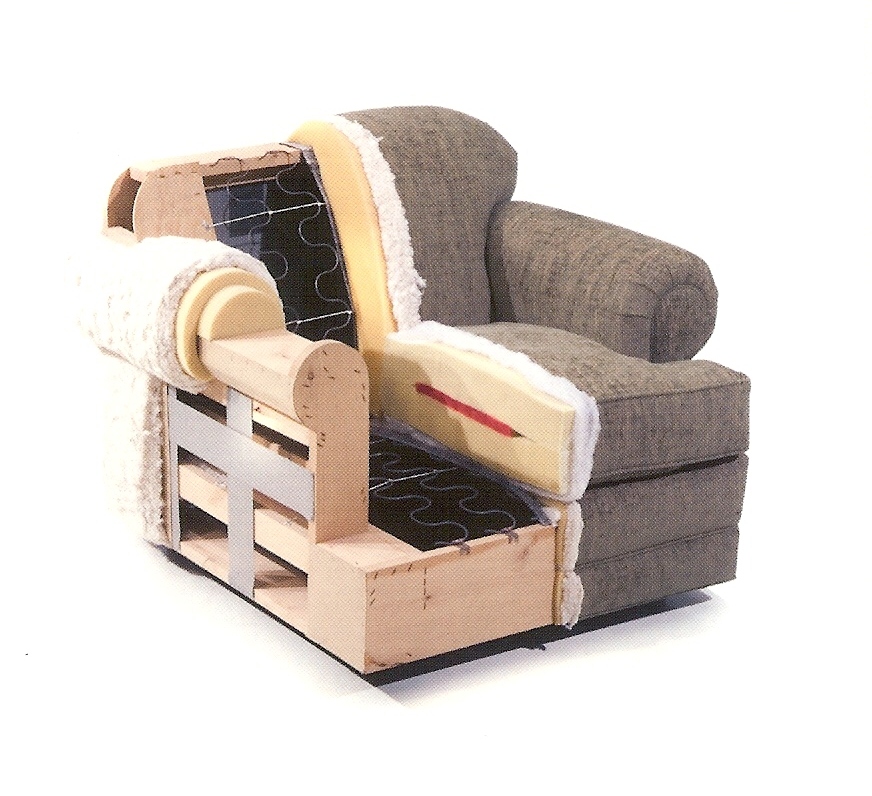 Flexible polyurethane foam is the most common cushioning material used in upholstered furniture....
Flexible polyurethane foam is the most common cushioning material used in upholstered furniture....Foam has a variety of applications in upholstery. Some are functional; others are aesthetic. And, the type of foam used varies from application to application. In other words, Lighter weight, greater strength, and ease of fabrication are some of the deciding factors in its success.
The versatility of different foam grades gives furniture designers more freedom to develop new ideas and to make specific designs work. For example, the right foam specification allows the designer to use a thin profile cushion and still provide comfortable seating. Or the right foam might allow a designer to create a very plush – yet durable – seat which minimizes dimension changes and loss of firmness during use. So, understanding the properties of polyurethane foam can play a big role in the ultimate styling of the finished furniture piece.
Quality control tests for polyurethane foam in furniture industry
key performance characteristics of flexible polyurethane foam are discussed below:
1. Density
Density is a measurement of the mass per unit volume. It is a primary measurement used to gauge flexible polyurethane foam (FPF) durability. The higher the density, the more durable the FPF, and the more expensive it is to produce due to greater material content.
Density and weight are now always directly proportional to the firmness of the material. Mostly it’s true that higher density foams that weigh more are firmer (more unyielding when pressed), but there are exceptions too. Therefore, density has a significant influence on how the foam feels and performs.
2. IFD
A measure of foam firmness that is independent of density. Firmness is an indicator of the surface feel of the foam. It is measured using the force in pounds required to indent a foam sample by 25% of its original height. This measurement is called Indentation Force Deflection (IFD). Firmness is independent of foam density, although it is often thought that higher density foams are firmer. Softer foams may be laminated to firmer foams to provide surface softness. Firmness can affect the “ride” of a cushion.
3. Compression modulus
Compression modulus is primarily a function of the type of foam. Quantifying support factor requires a second IFD measurement based on compressing a foam sample by 65% of its height. Support Factor (also known as Compression Modulus) assesses the foam’s ability to support weight. Typically, the more difference between the 25 percent IFD and the 65 percent IFD, the more ability the foam has to support weight. The ratio of the 65 percent IFD divided by the 25 percent IFD is called the foam’s support factor.
Conventional foams have compression modulus in the range of 1.9 to 2.1; filled foams 2.1 to 2.4; and high resilience grades 2.2 to 3.0. Within a foam grade, the modulus is typically a function of the foam density. In most cases, the higher the density the greater the compression modulus. Laminating hard and soft foams together can also increase compression modulus for the composite cushion structure. When cushions are thick, lower compression modulus foams may be used to improve cradling and to achieve more even distribution of body weight.
4. Flex fatigue (Dynamic Fatigue)
In flex fatigue testing, foam samples may be compressed a few thousand times, or many thousands of times. The percentage of IFD loss is then measured. Shorter tests provide an idea of how much firmness a foam may lose through initial use, while longer tests provide data on overall foam durability.
In other words, foams that have good flex fatigue values will tend to retain their original firmness and support levels, which means that the cushion can retain more of its original characteristics.
5. Resilience
The surface resilience of a foam also affects comfort and design. Resilience is an indicator of the surface elasticity or “springiness” of foam. Resilience can relate to comfort. Resilience is typically measured by dropping a steel ball onto the foam cushion and measuring how high the ball rebounds. Foam resilience ranges from about 20 percent ball rebound to as high as 80 percent rebound. Higher resilience in a foam often means that sofa seat cushions, for example, have a better “hand” or surface feel. Foams can also be made to have very low resilience for certain applications such as viscoelastic products.
6. Tear strength
Flexible polyurethane foams are also measured for their ability to resist tearing or shredding. The tests to determine these properties are tensile strength, tear resistance, and elongation. They determine the foam’s ability to be stretched or flexed without tearing. These durability measurements are particularly important for foams which contain large amounts of fillers, such as combustion modified foams. These additives can increase the tendency of foams to tear or shred.
Tests for tear strength analyze both long term durability and the foam’s ability to be handled during product assembly.
7. Roller shear
A particularly severe flex fatigue test is roller shear, where a rolling weight is run over a foam sample from two directions, typically for about 25,000 cycles. This test provides a combination of compression and abrasion, and helps identify how the foam would stand up to particularly difficult applications, such as commercial furnishings or as carpet cushion.
8. Hysteresis
Hysteresis is another laboratory test used to determine a foam’s ability to retain its original firmness properties. Hysteresis is measured by first indenting the foam sample 25 percent and measuring firmness, then indenting it 65 percent and again measuring firmness, and finally releasing indentation to the 25 percent level without allowing the foam to completely relax. Unlike other durability tests, Hysteresis can be performed quickly on a variety of foam samples.
9. Air flow
Foam performance is optimized when air flow is maximized. This indicates that cells are open and as flexible as they should be.





